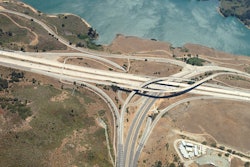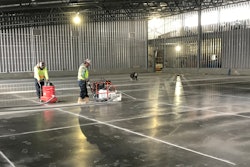
It's no secret that our roads, bridges and surface transportation infrastructure are in rough shape. It's one of the reasons a robust infrastructure bill is in the national news. As Congress continues to deliberate the details of an infrastructure package and the reauthorization of the nation’s surface transportation program, TRIP has released a new report on the condition, use and safety of the Interstate Highway System, the backbone of the nation’s transportation system. At 65 years old, our Interstate system is ready for retirement earlier than it should be.
The report, Meeting America’s Transportation Needs with a Reliable, Safe & Well-Maintained National Highway Network, includes the latest national and state-by-state data on Interstate pavement and bridge conditions, congestion, vehicle travel and fatality rates and also ranks states with the greatest share of Interstate pavements and bridges that are deteriorated, congested and most heavily traveled.
"As the U.S. Interstate Highway System reaches 65 years old, it is congested, carries significant levels of travel – particularly by large trucks – and lacks adequate funding to make needed repairs and improvements," the report said. "America’s most critical transportation link will need to be rebuilt and expanded to meet the nation’s growing transportation needs."
Needs Not New
According to the 2019 TRB report, the Interstate system has a persistent and growing backlog of physical and operational deficiencies as a result of age, heavy use This chart ranks states whose Interstate systems are the most congested, have experienced the greatest increase in vehicle miles of travel (VMT) since 2000, are busiest (based on daily travel per lane mile), have the largest share of pavement in poor condition, and have the greatest share of bridges in poor/structurally deficient condition.TRIP
This chart ranks states whose Interstate systems are the most congested, have experienced the greatest increase in vehicle miles of travel (VMT) since 2000, are busiest (based on daily travel per lane mile), have the largest share of pavement in poor condition, and have the greatest share of bridges in poor/structurally deficient condition.TRIP
“The report released by TRIP confirms what American businesses experience every day—our Interstate Highway System, which was once the envy of the world, is in serious need of modernization,” said Ed Mortimer, vice president of transportation infrastructure, U.S. Chamber of Commerce. “Commitment to modernization must be shared by federal, state and local leaders as well as the private sector. The Interstate system plays a key national role in economic success and quality of life for every American, and we urge bipartisan solutions this year to address this critical issue.”
Findings On Deterioration:
A state by state breakdown was found in the TRIP Report, ranking Hawaii, Delaware, New Jersey, Louisiana, New York, Colorado, Michigan, California, Maryland and Indiana the states with the most Interstate pavements in poor condition.
“While a lot has changed this past year, one thing remained constant: Michigan’s roads didn’t magically improve and we’re still operating well below adequate levels of funding to make the necessary repairs and improvements," Mike Nystrom, executive vice president of the Michigan Infrastructure & Transportation Association said. The TRIP report has found – unsurprisingly – that Michigan continues to rank in the top states nationally with pavement and bridges in poor and structurally deficient conditions. Even more concerning is that the report found that our interstate system needs more than double the current funding it receives."
TRIP’s report finds that while pavement smoothness on most segments of the Interstate system is acceptable, the crumbling foundations of most highway segments need to be reconstructed, and that continued resurfacing — rather than addressing underlying foundational issues — is resulting in diminishing returns and results in shorter periods of pavement smoothness.
Findings On Congestion:
The TRIP report found that from 2000 to 2019, travel on the Interstate system, the importance of which was heightened during the COVID-19 pandemic, has increased by 26 percent — a rate nearly triple that at which new lane capacity was added. As a result, 47 percent of urban Interstate highways are considered congested during peak hours. Due to the COVID-19 pandemic, vehicle travel on U.S. highways dropped by as much as 45 percent in April 2020 (compared to April 2019) but rebounded to six percent below April 2019 levels by April 2021.
Findings On Safety:
The design of the Interstate – which includes a separation from other roads and rail lines, a minimum of four lanes, paved shoulders and median barriers – makes it more than twice as safe to travel on as all other roadways. The fatality rate per 100 million vehicle miles of travel on the Interstate in 2019 was 0.55, compared to 1.30 on non-Interstate routes. TRIP estimates that additional safety features on the Interstate Highway System saved 6,555 lives in 2019.
Based on the findings of the TRB Interstate report, TRIP has provided a set of recommendations for the restoration of the Interstate Highway System, which includes: the foundational reconstruction of Interstate highways, bridges and interchanges; improvement to roadway safety features; system right-sizing, including upgrading of some roadway corridors to Interstate standards; adding needed additional highway capacity on existing routes; adding additional corridors; and, modifying some urban segments to maintain connectivity while remediating economic and social disruption.
“The long-term vision that helped establish the current Interstate Highway System 65 years ago is needed again today,” said Dave Kearby, TRIP’s executive director. “A modernized Interstate system will be critical to the nation’s ability to fully recover from the COVID-19 pandemic and will require adequate investment in a federal surface transportation program that provides states and local government the funding and flexibility they will need to restore the nation’s most critical transportation link.”



















